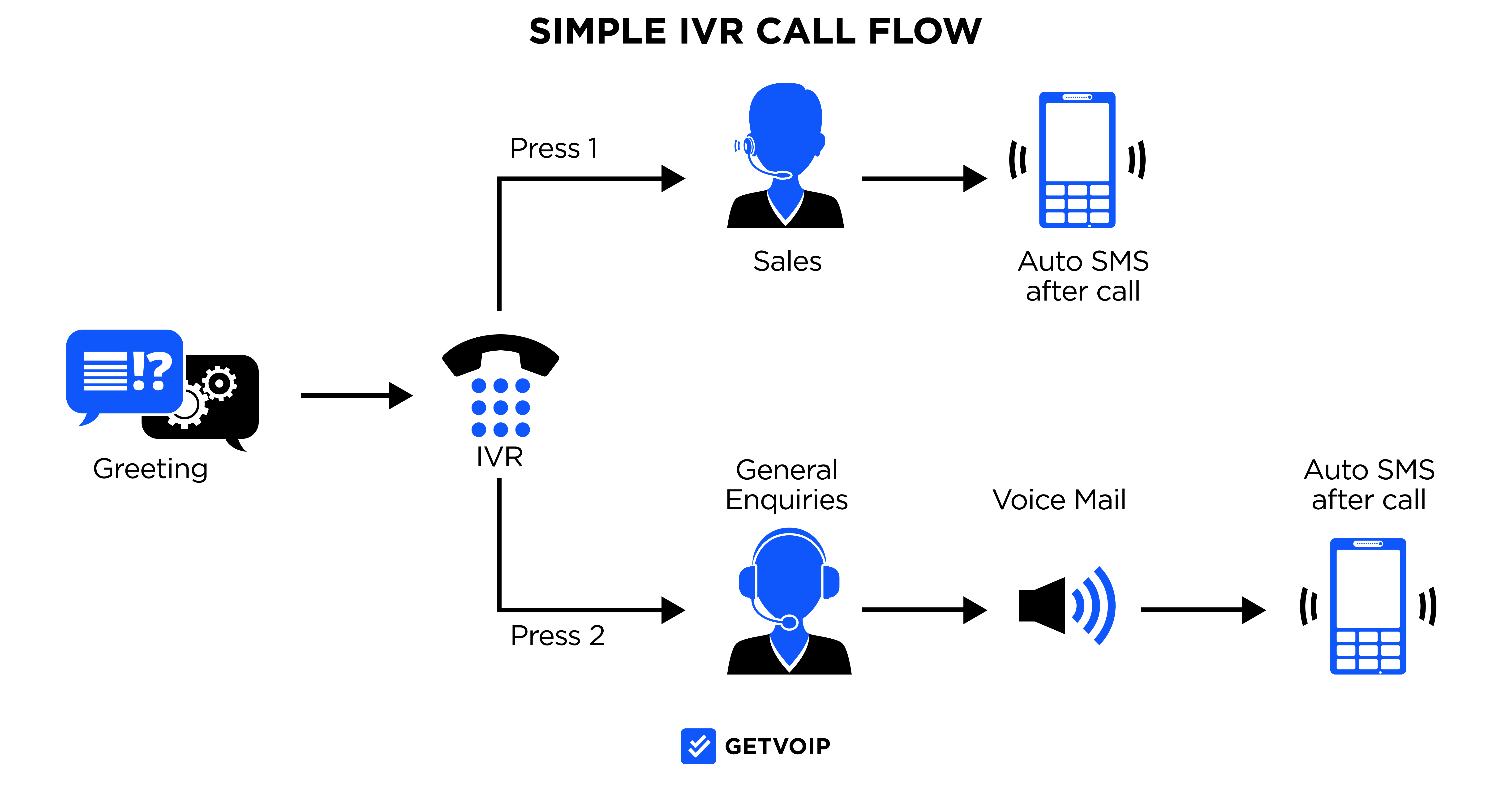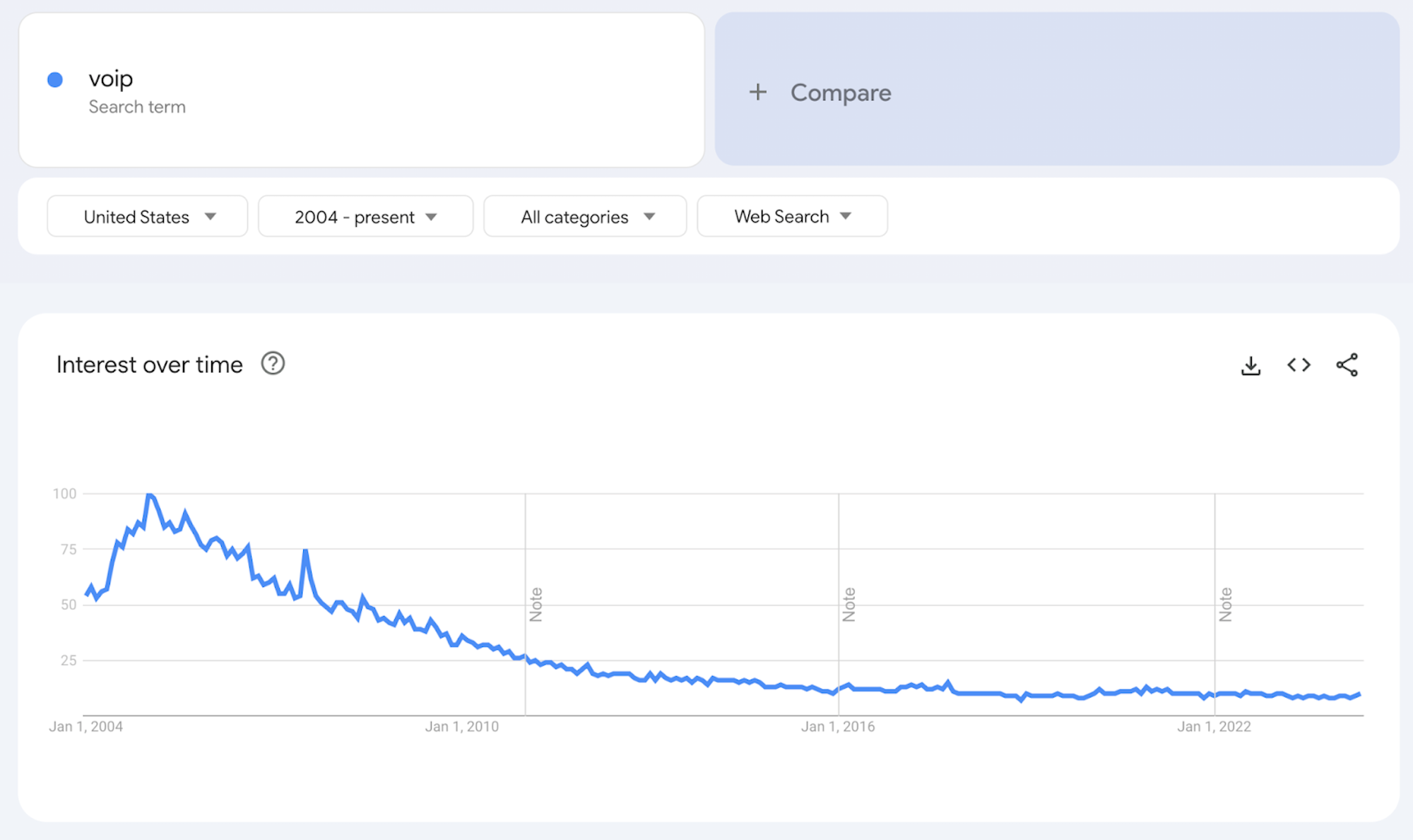VoIP phone systems offer competitive pricing, portability, and advanced features that streamline business communications and improve the customer experience.
This introduction to VoIP covers what VoIP is and how it works, how it’s different from landline service, its pros and cons, key features to look for, the average cost of VoIP service, and how to choose the right VoIP phone system for your business.
- What is VoIP?
- How it Works
- VoIP vs Landline
- Pros and Cons
- Key VoIP Features
- VoIP Cost
- Choosing VoIP Provider
- The Future of VoIP
- FAQs
What is VoIP?
VoIP (Voice over Internet Protocol) is a voice communications technology that makes and receives telephone calls over the Internet instead of the traditional wired analog network.
Because VoIP phone systems are cloud-based, they don’t require extensive on-site installation, copper wiring, or bulky hardware like landlines do. VoIP phone systems are accessible on any device and in any location with a working broadband Internet connection. Therefore, VoIP users can make and receive softphone voice calls on desktop and laptop computers, smartphones, tablets, IP phones, or even on traditional landlines that connect to the VoIP network via analog telephone adapters (ATAs).
VoIP is also known as Voice over IP, virtual telephony, a cloud phone, or an online phone system.
How Does VoIP Work?
VoIP works by breaking up outbound voice audio into digital data packets that are sent to their destination via the Internet, where they reassemble back into standard voice audio and play to the call recipient.

VoIP codecs compress and decompress the voice data packets for two-way travel over a wide area or local area IP network. These codecs transmit voice signals between devices as efficiently as possible, providing HD audio and eliminating call quality issues like jitter and latency.
VoIP vs Landline Phone Service
The table below outlines the main differences between VoIP and landline phone systems:
| VoIP | Landlines | |
| Facilitates Calling via | Broadband Internet connection and VoIP codecs | Copper wiring and fiber optic cables of the PSTN |
| Compatible Devices | Any Internet-connected device (IP phone, smartphone, tablet, desktop/laptop computer via softphone interface) | Analog phone (landline) only |
| Calling Costs | Free unlimited local and long-distance calling, affordable international calling rates | Users are charged for all calls and long-distance/international calls incur additional expenses |
| Reliability | 99.9% minimum uptime guarantee, but will need a backup power source during a power outage | May still be functional during a power outage |
| Scalability | Additional phone numbers, lines, features, and user seats can be purchased directly on the provider's website and set up in minutes | Adding more phone lines requires additional wiring, desk phones, and a lengthy setup/installation process |
VoIP Pros and Cons
Switching from analog phones to VoIP lowers operating costs, gives you instant access to advanced features, and empowers remote teams. However, be prepared for a bit of a learning curve–and check to ensure you have sufficient bandwidth to power VoIP-based communication.
Here’s some additional insight into VoIP pros and cons:
VoIP Pros
- Cost savings: Switching from landlines to VoIP can lower communication costs by up to 70% by eliminating the need for expensive equipment and its maintenance, offering unlimited long-distance calling, and by decreasing the average cost per call with features like IVR, call routing, and automated callbacks. Though VoIP plans include unlimited local/long-distance calling, pay-as-you-go bundled minutes offer further cost savings.
- Portability: VoIP gives remote/hybrid teams instant access to their business phone systems anywhere with Internet access. Team members can take calls, review and update client information, and collaborate on projects on their preferred desktop and mobile devices–and business owners can eliminate the expense of office space.
- Advanced features: Access to advanced VoIP features like ring groups, auto dialers, call forwarding, and virtual receptionist can increase team productivity by up to 20%.
- Scalability: VoIP providers offer bundled plans with tiered pricing, helping users avoid paying for features and seats they don’t need. Users can scale up or down depending on their business needs or purchase individual features as add-ons instead of upgrading to a higher, more expensive tier.
VoIP Cons
- Learning curve: Though VoIP comes with advanced communication and collaboration tools, expect a bit of a learning curve when switching to VoIP for the first time. Quality VoIP providers offer on-demand an custom webinars to streamline the onboarding process
- Call quality dependent on Internet connection: VoIP requires a minimum bandwidth of 100 kbps per line, meaning you may need to upgrade your Internet speed to avoid jitter, latency, and dropped calls. To avoid service losses during a power outage, get a backup power source and ensure your provider offers network redundancy.
- Less end user control: VoIP providers are responsible for network maintenance, uptime, security, device compatibility, and available features–meaning you’ll have less control than you would with a traditional premise-based phone system.
Key VoIP Features
Though there are over 100 VoIP features -- and counting! -- to choose from today, we’ve outlined the essential functionalities that define virtual phone communication.
Call Routing
Call routing is a call management strategy that distributes incoming calls according to preset rules, ensuring each customer reaches the best available agent as quickly as possible.

Popular call strategies like skills-based, round robin, and relationship-based routing decrease call wait times while increasing FCR, leading to higher customer satisfaction levels and optimized agent schedules.
Interactive Voice Response (IVR)
Interactive Voice Response (IVR) is a VoIP self-service option that lets customers direct their own calls by responding to pre-recorded call menus via touch tone or by speaking their answers directly into the phone.

IVR systems free up agents by assisting with common, repetitive customer service requests like account balance requests, appointment scheduling, and bill payments. Often, IVR entirely eliminates the need for callers to speak with a live agent.
Auto Dialers
Automated outbound dialers (auto-dialers) expedite lead list penetration by automatically dialing lead list telephone numbers, filtering out busy/disconnected numbers, and connecting agents only to live prospects.

Today’s auto dialers are TCPA-compliant and offer a variety of dialing strategies like predictive, progressive, power, and preview modes.
Call Recording
Automated or on-demand call recording and transcription lets call center managers review customer-agent interactions for quality assurance. Recordings are stored in a searchable cloud database with custom retention policies. Ensure you comply with local and federal call recording laws before setting up this feature.
Visual Voicemail
Visual voicemail is a VoIP voice-to-text feature that automatically transcribes voicemail messages, while voicemail-to-email tools instantly send these voicemail transcripts to your preferred inbox. As with call recordings, all voicemail recordings and transcripts are stored in a searchable database and have custom retention policies.
Call Forwarding
Call forwarding is a call distribution strategy that automatically sends (forwards) incoming calls to different telephone numbers associated with the same agent or department in a pre-set order.

Forwarding calls allows for greater team flexibility and eliminates the need for agents to be physically tied to a single location to take calls. It also prevents callers from having to hang up and dial multiple phone numbers to reach the desired agent.
How Much Does VoIP Cost?
The average cost of VoIP phone services ranges from $20-$50+ and up per user, per month depending on the specific provider, plan, and included or add-on features. Additional factors like hardware, selected VoIP phone numbers, regulatory fees, VoIP taxes, special discounts, and the number of seats needed also impact the total cost of VoIP solutions.
Here’s a summary of the average VoIP costs:
| Pricing Factor | Average Cost |
| One-time setup/installation fee | Varies by provider, generally $50-$100 |
| One-time number porting fee | Usually free, but can cost up to $20/number |
| Monthly service fee | $20/user/month for mid-range plans |
| Hardware fees (one-time, ongoing if renting equipment) |
|
| Regulatory fees | $5.00/user/month |
| Gross Revenue Surcharge | $1.00-$3.00/user/month |
| VoIP taxes | $7.00/user/month |
| Universal Service Fund fees | $2.00-$4.00/user/month |
| E911 fees | $0.20 to $2.00/user/month |
| Additional phone numbers | Local Phone Number: $5.00/number/month
Toll-Free Number: $10-$15/number/month Vanity Number: $15-$20/number/month |
For more details, read our guide on VoIP pricing and plans.
What to Look For in a VoIP Provider
When choosing a VoIP provider, the most important things to consider are:
- Scalability: Does the provider offer multiple tiered plans, each with different features suites, user minimums/caps, bundled toll-free minutes, and storage space? When examining pricing, look for the plan with the best value–keeping in mind that it may not be the lowest-priced tier.
- Available features: Make a list of the most essential VoIP features for your business, considering which features you need immediately, which ones you may want in the future, and which ones are “nice to have.” Then, examine the included and add-on features of each plan.
- Hardware compatibility: If you want to continue using existing hardware like desk phones, speakers, or headsets, ensure they’re compatible with your VoIP provider–and that, if needed, the provider offers assisted device provisioning for third-party hardware. If not, most providers offer compatible devices for rental or sale directly on their website.
- Third-party software integrations: Make sure the platform integrates with your existing third-party software, including CRM systems, collaboration and chat tools, workforce management solutions, etc. Review the provider’s developer community, APIs, and SDKs.
- Customer service and support: Evaluate the provider’s available support hours and channels by plan (24/7/ support is normally reserved for higher-tiered plans). Look into paid priority support options, custom onboarding and training availability, and average incident response/resolution times,
- Network reliability: VoIP providers should offer a minimum SLA uptime of 99.9%, have network geographic redundancy, and offer 24/7/365 network monitoring with a public system status page on their website
- Platform security: In addition to standard security features like end-to-end encryption, access control, and custom data retention policies, review the provider’s security certifications. Top providers should be HIPAA, PCI, and GDPR compliant, offer 24/7 network monitoring, and be ISO/IEC 27001 certified, at minimum.
- Current user reviews: Comparison shop for VoIP phone systems by reading current user reviews, expert guides, and head-to-head business VoIP comparisons. Keep in mind that some providers may post overly positive reviews on third-party review sites or message forums, so always take a look at the post author’s history to ensure you’re getting balanced opinions from actual users.
- Provider demos: Quality VoIP providers offer interactive demos and/or free trials that help you and your team evaluate the platform’s ease of use, features, interface, and mobile apps. Solicit feedback from team members across departments to ensure the provider is the right fit for everyone on your team.
Unified Communications: The Future of VoIP
Although VoIP adoption was on the rise long before the 2020 pandemic, COVID made it a household name. In March of 2020 alone, VoIP usage increased by an astounding 212%--and it’s shown no signs of slowing down ever since. With an estimated annual CAGR of 21.1% from 2022 to 2031, the VoIP market is expected to be valued at $327.5 billion by 2031.
Why then (as the below image shows) has consumer interest in the topic slowly decayed over time?

Because “VoIP” has expanded to include so much more than just voice calling in the past few years. Today, when consumers talk about “VoIP,” they’re really talking about unified communications as a whole: voice calling, video conferencing, team chat, business text messaging, collaboration tools, website chat, online faxing, and, more recently, AI-powered workforce management. Consumer interest hasn’t shifted away from VoIP, but “VoIP” has become somewhat of an outdated term.

Today, consumers are much more likely to refer to VoIP platforms as “omnichannel contact center solutions” or “unified communications providers” --and given everything that VoIP technology powers, it may be a more accurate term.
Now that you know what to look for in a VoIP telephone service, start comparing VoIP platforms to find the option that best suits your current and future business communication needs.
FAQs
Below, we’ve answered some of the most common VoIP questions.



